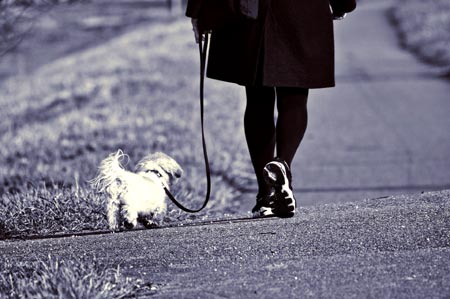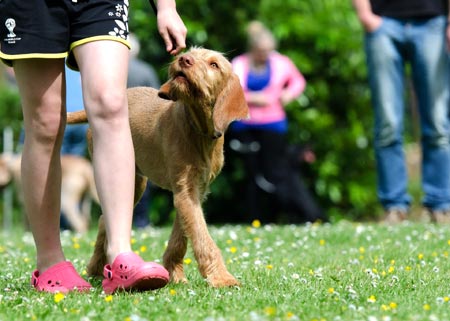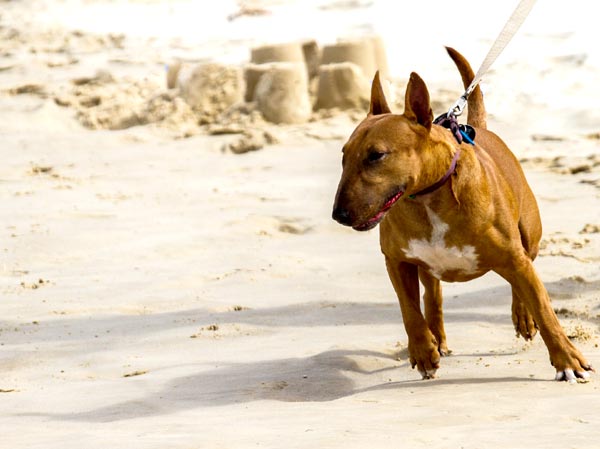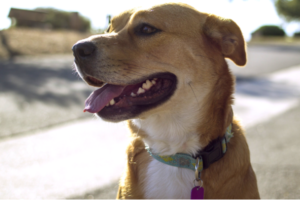How To Walk A Dog
This is such a basic thing that most people don’t think to ask, “So how do I walk a dog?” I think some people believe you just hold onto the leash and that’s it. Let’s get the basics out of the way on how to walk a dog.
The basics are a collar, a leash, how to hold the leash, and finally the walking part. Oh, and you need a dog. Consider adopting from a dog rescue.
If you already know the basics, then skip below for:
You need to stay focused on the safety of the dog, especially if you are a new dog owner or are watching someone’s dog. Get yourself quality equipment (collar, harness, leash), knowledge of dog behavior and learn how to control your dog.
Types of Collars and Harnesses
Make sure to have a collar (or harness) and a leash that are the appropriate sizes. Just get a basic collar that fits and won’t slip off.
There are a number of other types of collars: choke collars, pinch collars and more. But let’s just stick to the basics. A simple collar made of nylon webbing with a quick release buckle should be fine.
Sometimes collars don’t give you the control you need. Other options of a connection point from the leash to the dog is the easy walk harness or a gentle leader.
I do not have a lot of experience with the gentle leader, so I can’t comment on them. But for harnesses, the Easy Walk harness is absolutely fantastic. You can also read my article on the Easy Walk and how to use it to stop your dog from pulling.
How to Hold a Dog Leash
The most common dog leash ordinance that I’ve seen is a maximum of a 6’ leash. So get a 6’ or shorter leash. Do not get an extendable leash for a new dog. You need to control the dog, and extendable leashes do not allow that.
As a dog walker, I put my hand through the loop of the leash and then slip the leash webbing between my middle and index fingers. That allows me to grab part of the leash below the loop with my hand.

The leash through my fingers is what makes it easy to grab the leash with my fist. Sometimes I will remove the leash from between my fingers and quickly wrap the leash around my wrist. I do that when I see a potential problem (read my article about dog walking dangers).
That is the approach I use until I know how a new dog I’m walking acts on a leash. You should consider doing the same until you find what works for you.
One more thing. Most articles mention holding the leash in your left hand because that’s what professional trainers and fancy dog show handlers do. I say use your dominant hand, right or left. Your choice.
How To Walk A Dog On A Leash

You must be in control of the dog, not the other way around. Some people call it the alpha dog or pack leader approach. Whatever. Be in control for the safety of everyone, including your dog.
A shorter leash gives you more control than a longer one. That’s why extendable leashes are bad to use in the beginning.
A great technique to show dominance is to be the first one to walk out of the door, not your dog. Continue to open and close the door if the dog tries to go first. Repeat as many times as necessary.
If you are not even in control of your dog at the door, how are you going to be in control outside? [Click to Tweet]
Your goal is to walk with a slack leash. Not dragging the dog behind you or having the dog pull you. You also want to keep the dog on the same side as the hand that you are using to hold the leash.
Don’t allow him to cross your path. A dog that circles around you can literally make you trip and fall.
So the ideal situation is to walk your dog with a slack leash and to have the dog walking alongside you. Simple, right? It is simple if the dog never pulls.
How To Walk A Dog That Pulls
Actually, you don’t want to learn how to walk a dog that pulls. You want to learn how to stop the pulling so you can have a pleasant walk.
Once you stop the pulling, the walking part becomes much easier. You need to teach him that if they pull you stop walking, and they don’t get treats or get to walk farther.
There is no shortage of articles on how to walk a dog that pulls. But the actual techniques are the same from article to article.
The Techniques to Stop Pulling
Here is my list of techniques to stop the pulling:
- Practice without distractions.
- Stopping and changing direction when he pulls.
- Positive reinforcement with treats.
- Raising the bar by varying your speed and frequently changing direction.
Try walking your dog on a leash in your house at first, then in your yard. Start with short sessions, maybe 5 minutes. And use treats as rewards.
The rewards are for when your dog does what you want, and that is to have him follow you. So each time the dog pulls, immediately stop. Then turn around and walk in the opposite direction.
Just like with the door, you will have to repeat this step over and over. Stop and turn, stop and turn, stop and …as many times as it takes.
Reward with treats each time he follows you or when he stops. You can also use the treats to lure him back to your side. Use positive verbal communication when he does what you want.
Then mix things up by varying your walking speed. Sometimes fast and sometimes slow. And remember to do full stops with changes in speed and direction. Start decreasing the treats as he progresses.
Walking Your Dog on a Leash Outside
When you start having success in the house or yard, then take him outside. But the process is the same, just with more distractions. Stop and change direction if he starts to pull. And use treats as rewards the same as you did in your yard (decrease them as he improves).
It will be challenging when you pass other dogs or people. You can try a gentle leader or an easy walk if you are having problems.
You can allow some pulling to the side of you for sniffing and peeing. Allow them time to smell the world. Use gentle leash pressure if they get distracted. Never pull or jerk the leash.
So it will be annoying at first to constantly stop and change direction each time he pulls. But that’s what you have to do. There is no way around that. Just keep doing it and you will start to see improvements.
How To Train Your Dog To Walk Next To You

The command “heel” means to have your dog walk directly next to you, not behind or in front of you. And he has to match your pace: stopping when you stop and walking when you walk.
Being a dog walker, I feel that sit, stay, come and heel are the most important commands. I don’t need about any of the other commands. Heel is the final command you need if you want to be able to walk your dog without a leash.
Keep in mind that I’m a not a dog trainer, so this particular training method is out of my range of expertise. This is a big subject and worthy of its own article. But this command is the end goal – having total control of your dog.
I walk my dog off leash when there are no other dogs or people around. He goes to bathroom quicker when he is off leash. DO NOT walk your dog off leash unless you have total control of your dog.
The Techniques to Have Your Dog Walk Beside You
To teach your dog to walk beside you, just repeat the steps above but now the treats are to lure him next to you and if he stays by your side. Start in your house or in your yard.
Start slowly and only take a few steps at a time. This is an advanced technique, so make it easy for him. Walk slowly and hold a treat out in front of you. And if he veers off to the side or pulls ahead, stop immediately. Lure him back to your side with a treat and start again.
As he improves, decrease the treats until he can walk by your side without getting treats. Then try it outside where there are more distractions and smells.
Good luck and I hope you are able to walk your dog on a leash without him pulling. It just takes time and patience. If you are interested, I found a link that lists some of the top dog training websites. Just in case you found training your dog a lot of fun and want more.



